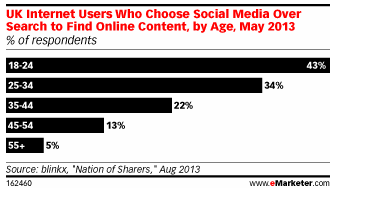Marketers may need to prepare sooner rather than later for the merger of social media content and search. Some sites have already made strides toward this end, with Facebook introducing Graph Search and Bing bringing commentary from social directly to results pages. However, the key to making it work is user buy in. Without consumers’ support, new features will fall flat.
A new study from Blinkx Video suggests people are embracing a hybrid channel, as 43 percent of surveyed 18- to 24-year-olds from the United Kingdom say they turn to social networks to discover online content over search engines. The same was true for 34 percent of 25- to 24-year-olds and 22 percent of respondents between the ages of 35 and 44.
This could be the result of networks’ efforts to improve the quality of digital content surfaced in news feeds. As one example, Facebook recently announced an updated algorithm that takes new factors into consideration when determining which posts to display, including relevance, timeliness and audience centricity. If users continually see posts that pertain to their interests, rather than being inundated with news about long-lost acquaintances, they may begin to see the channel as a source of information.

Likewise, LinkedIn is realizing its potential as a platform for content creation and publication, Brafton recently reported. By offering organic news pieces and promotional content, the network aims to keep professionals informed of developments in their industries.
As the division between search and social comes to a close worldwide, marketers must be certain the content they share across platforms works seamlessly together. In the past, brands might have distributed social media content that primarily promoted their brands or showcased products. Members looking for information on networks want more than that – they want to read stories containing fresh information and exclusive insights.





